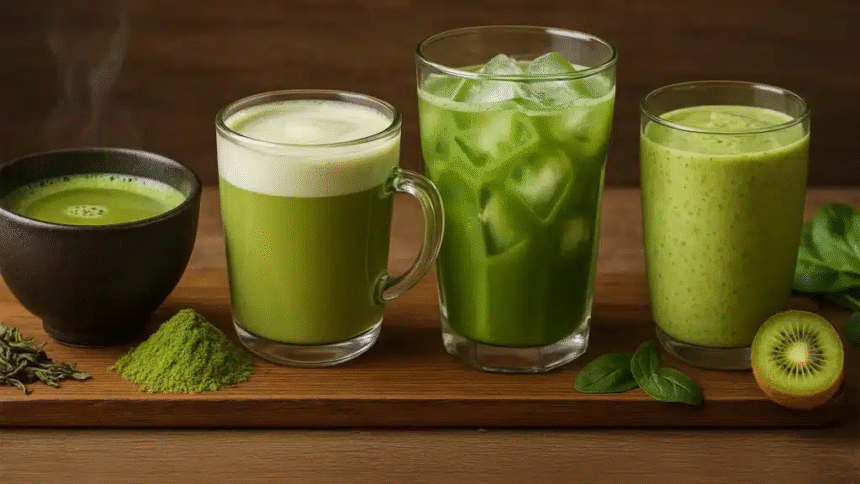If you’ve ever been curious about Japanese green tea powder and wondered what does matcha taste like, you’re not alone. Over the past few years, matcha has become a global favorite, not just in traditional Japanese tea ceremonies but also in everyday drinks like lattes, smoothies, and even desserts. People often fall in love with its vibrant green color, creamy texture, and earthy, rich flavor. But the taste of matcha can be hard to describe if you’ve never tried it.
This beginner’s guide will break down exactly what matcha tea tastes like, what influences its flavor, how a matcha latte tastes, and how to enjoy it even if you’re trying it for the first time.
What Does Matcha Taste Like?
The short answer: matcha has a grassy, earthy, slightly sweet, and umami-rich taste. Unlike other teas that are steeped and then discarded, matcha is a finely ground whole-leaf green tea powder that you whisk directly into hot water or milk. This means you consume the entire tea leaf, which makes the flavor much more intense than a typical green tea.
Some people describe it as smooth with a hint of natural sweetness, while others find it slightly bitter or vegetal, depending on the quality of the powder and how it’s prepared. If you’ve ever tasted spinach, nori seaweed, or fresh green vegetables, you’ll notice some similarities.
What Does Matcha Tea Taste Like?
When consumed in its purest form (just hot water and whisked matcha), matcha tea tastes fresh, earthy, and rich in umami. The flavor is unique because of how the tea is grown: before harvest, the tea plants are shaded for about 3–4 weeks. This increases their chlorophyll content, giving matcha its bright green color and deep vegetal notes.
The taste of matcha tea can be broken down into several layers:
-
Fresh and grassy: Similar to spring greens, spinach, or steamed kale.
-
Savory umami: That rich backbone of flavor that makes it complex and comforting.
-
Slight natural sweetness: High-quality ceremonial-grade matcha often has a subtle sweetness without additives.
-
Smooth creaminess: When whisked well, matcha forms a frothy top that feels silky on your tongue.
-
Light bitterness: Lower-quality or improperly prepared matcha may taste more bitter or astringent.
This complexity is why matcha has been consumed in Japanese tea ceremonies for centuries—it’s more than just tea; it’s an experience of layered, evolving flavors.
What Does a Matcha Latte Taste Like?
Now if you’re wondering what does a matcha latte taste like, the answer is: creamy, slightly sweet, and less bitter than pure matcha tea. Instead of whisking the green tea powder with hot water, you mix it with steamed milk (like oat, almond, soy, or dairy milk).
A matcha latte balances the earthiness of matcha with the natural sweetness of milk. The result is a drink that feels more accessible and dessert-like, especially for beginners.
Here’s what you can expect in a typical matcha latte flavor profile:
-
Creamy and smooth: Milk makes the flavor less intense and more comforting.
-
Subtly sweet: Even without added sugar, a matcha latte tastes mellow compared to straight tea.
-
Balanced umami: The milk softens strong vegetal notes.
-
Customizable taste: Sweeteners like honey, vanilla, or syrups enhance the flavor while keeping the goodness of matcha intact.
That’s why matcha lattes are the most popular introduction for people trying matcha for the first time.
What Does Matcha Green Tea Taste Like?
You might still be asking: what does matcha green tea taste like compared to regular green tea?
The difference is that regular green tea is steeped (water extracts a portion of the flavor), while matcha is ground leaf powder that you drink fully. This makes matcha bolder, richer, and creamier, with a more distinct umami taste. On the other hand, regular green tea is lighter, cleaner, and less intense.
In simple terms:
-
Green tea = subtle, light, refreshing.
-
Matcha = bold, creamy, earthy, and layered.
Factors That Affect Matcha Taste
Not all matcha tastes the same, and several factors affect what you’ll experience when you try it:
-
Quality of matcha:
Ceremonial grade matcha is made with the youngest tea leaves, resulting in a smoother, naturally sweet taste. Culinary grade matcha, often used in baked goods or lattes, has a stronger, slightly more bitter flavor. -
Preparation method:
The ratio of powder to water, the whisking technique, and whether you add sweeteners or milk all change the taste significantly. -
Storage:
Matcha is sensitive to air, heat, and light. Freshly opened matcha is vibrant, while older or poorly stored matcha can taste flat or dull. -
Origin:
Authentic Japanese matcha from regions like Uji and Nishio often has a superior taste compared to cheaper alternatives sourced from elsewhere.
Why Some People Don’t Like Matcha (At First)
For some beginners, the first sip of matcha can feel overwhelming because it is richer and more vegetal than they expect. If you’re used to sugary lattes or mild teas, the boldness of pure matcha might surprise you. However, many people grow to love its complexity after trying it in different forms, like lattes, smoothies, or desserts.
The key is to start with high-quality, ceremonial-grade powder and adjust preparation methods to your preference.
Health Benefits Add to the Taste Experience
What makes the flavor of matcha even more enjoyable is knowing it’s packed with health benefits. Matcha contains:
-
High antioxidants (especially catechins, like EGCG)
-
Calm focus due to L-theanine
-
Sustained energy from natural caffeine (without jitters)
-
Supports metabolism and detoxification
For these reasons, matcha has become not just a beverage but also a wellness choice. If you’d like to learn more about the science behind green tea benefits, you can explore detailed resources provided by Harvard School of Public Health (Harvard Nutrition Source on Tea).
How to Develop a Taste for Matcha as a Beginner
If you want to enjoy matcha but feel uncertain about the flavor, try these beginner-friendly tips:
-
Start with a latte: Make it with almond, oat, or cow’s milk for a smooth introduction.
-
Use natural sweeteners: Honey, maple syrup, or vanilla can soften the vegetal notes.
-
Experiment with recipes: Matcha smoothies, muffins, or ice cream offer a gentler flavor.
-
Buy high-quality matcha: Poor-quality matcha tends to be overly bitter. Look for bright green ceremonial grade.
-
Learn proper preparation: Use a bamboo whisk (chasen) to create a frothy, balanced drink.
Read More: Are Epicurean Cutting Boards Toxic? The Facts Explained
Final Thoughts: What Does Matcha Really Taste Like?
So, what does matcha taste like? The answer is a vibrant blend of earthy, grassy freshness balanced with natural sweetness and rich umami. Straight matcha tea offers a bold, full-bodied flavor, while a creamy latte brings out matcha’s milder, sweeter side. Compared to regular green tea, matcha is stronger, richer, and far more complex.
If you’ve never tried it before, don’t be discouraged if the first sip feels unusual. Matcha is an acquired taste, but once you explore it in different forms—tea, latte, or even desserts—you’ll discover why it has captivated people for centuries. And beyond taste, matcha brings not just energy and calm, but also an appreciation for slow moments of mindfulness.









